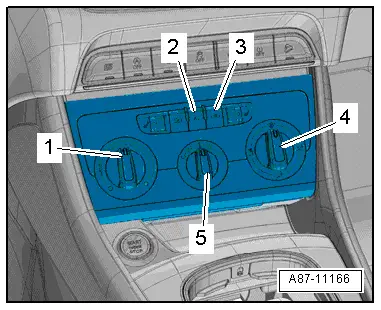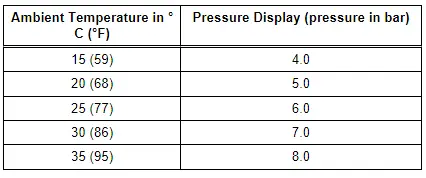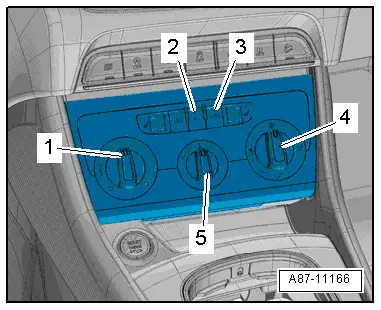Audi Q3: Cooling Output, Checking, Manual Climate Control System
Procedure
- The requirements for testing the cooling capacity are fulfilled. Refer to → Chapter "A/C Cooling Output, Testing Requirements".
- Measure the ambient temperature (must be warmer than 15 ºC (59 ºF) ).
- Close the doors, the engine hood, the windows, the sunroof and the rear lid.
- Open all instrument panel vents.
- Start the engine.
- Switch off the A/C compressor. The indicator lamp in the AC or A/C button -2- does not illuminate.
- "Read measured values", Air Conditioning (A/C) system using the Vehicle Diagnostic Tester in the "Guided Fault Finding" function.
Checking
- Read the actuation of the A/C Compressor Regulator Valve -N280-.
- The activation of the A/C compressor is switched off and 0% is displayed.
- Read the measured value for the High Pressure Sensor -G65-.
- The pressure in the refrigerant circuit is same as the measured outside temperature or greater than the value in the chart.


 Note
Note
- At absolute pressure, 0 bar corresponds to absolute vacuum. Normal ambient pressure equals approximately 1.0 bar (14.5 psi) absolute pressure and 0 bar pressure. On the scales of most pressure gauges, 0 bar pressure corresponds to an absolute pressure of one bar (can be seen from -1 mark below 0).
- Depending on the version of the A/C Control Module -J301-, only integer values may be displayed as measured values. If the measured pressure is between two values, the display alternates between the two values.
- Pressure in refrigerant circuit is governed by ambient temperature. On account of heat given off by components (for example, the radiator), pressure displayed with warm engine will be slightly higher than that given for the respective ambient temperature.
If pressure displayed is below that indicated in table:
- Check the signal of the High Pressure Sensor -G65-. Refer to Vehicle Diagnostic Tester in the "Guided Fault Finding" and → Chapter "High Pressure Sensor -G65-, Checking Pressure Signal".
- If no fault can be determined at the High Pressure Sensor -G65-, then there is not enough refrigerant in the circuit. Bring the vehicle to a workshop that has the necessary tools and in which the work can be performed accordingly by qualified personnel. Refer to → Refrigerant R134a Servicing; Rep. Gr.87; A/C System, General Information (Refrigerant R134a, Servicing; A/C System, General Information).
If the Refrigerant Circuit Pressure is OK.
Adjust the following settings on the A/C Control Module -J301- control head:
- Turn the temperature knob -1- to the "cold" stop.
- Turn the air distribution knob -4- to the "instrument panel vent" stop.
- The A/C compressor is on - the indicator lamp in the AC or A/C button -2- illuminates.
- The recirculating air mode is on - the indicator lamp in the recirculation button -3- illuminates.
- Turn the knob -5- for the fresh air blower to level "4".
- "Read measured values", A/C system using the Vehicle Diagnostic Tester in the "Guided Fault Finding" function.
- Check the display in the display fields:
- The current calculated by the A/C Control Module -J301-, which flows via the A/C Compressor Regulator Valve -N280- is greater than 0.3 Amps (the A/C compressor is switched on)
- The displayed pressure increases above the value when the compressor is switched off.
 Note
Note
- If the pressure displayed does not change and yet the A/C compressor activation is OK, make sure the calculated current is actually flowing via the A/C Compressor Regulator Valve -N280- and that the A/C compressor is actually being driven. There is a fault in the refrigerant circuit If the current is flowing via the A/C Compressor Regulator Valve A/C Compressor Regulator Valve -N280- and the A/C compressor is being driven. Bring the vehicle to a workshop that has the necessary tools and in which the work can be performed accordingly by qualified personnel. Refer to → Refrigerant R134a, Servicing; Rep. Gr.87; A/C System, General Information (Refrigerant R134a, Servicing; A/C System, General Information). If the A/C compressor control is not OK, then inform the workshop of the problem at hand.
- The A/C Control Module -J301- actuates the A/C Compressor Regulator Valve -N280- so that the air temperature reaches the specified value downstream of the evaporator (approximately 2º to 5 ºC (36º to 41 ºF) ).
- After vehicle start, a value greater than 0.55 A is displayed for the activation of the A/C Compressor Regulator Valve -N280- depending on the measured temperature, the engine speed and the vehicle voltage. As soon as the temperature measured by the Evaporator Vent Temperature Sensor -G263- nears the specified value, the activation, and thus the compressor output, is reduced.
- Under certain operating conditions, moisture in the refrigerant circuit can lead to ice build-up on the A/C Compressor Regulator Valve -N280- (and on the expansion valve). A/C compressor regulation is reduced by this ice build-up. The evaporator is cooled too intensely and freezes. The ice on the evaporator may cause various customer concerns. Refer to → Chapter "Ice Formation on Evaporator, Localizing Malfunction".
- If no or very little current is displayed in the measured values for the A/C Compressor Regulator Valve -N280- actuation, check the actuation of the A/C Compressor Regulator Valve -N280-. Refer to Vehicle Diagnostic Tester in the "Guided Fault Finding" function.
- Certain functions on the A/C Compressor Regulator Valve -N280- (for example, a stuck valve or a disruption in the coil) can lead to a complaint regarding the A/C compressor (A/C system doesn't cool, the evaporator ices over, etc.). If the cause is with the A/C Compressor Regulator Valve -N280- (and not the A/C compressor itself), the A/C compressor can be serviced by replacing the A/C Compressor Regulator Valve -N280-. Refer to → Refrigerant R134a Servicing; Rep. Gr.87; Refrigerant Circuit Components, Replacing (Refrigerant R134a, Servicing; Refrigerant Circuit Components, Replacing).
- The A/C Compressor Regulator Valve -N280- is not available as a replacement part for all A/C compressors. If the A/C Compressor Regulator Valve -N280- is not available as an individual A/C compressor part (different versions), then the entire A/C compressor must be replaced. Refer to the Parts Catalog.


